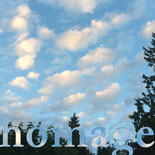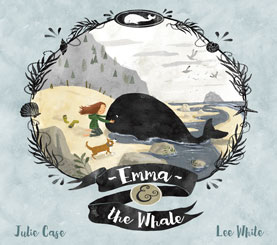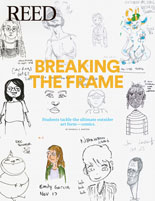
IRIS login | Reed College home Volume 96, No. 1: March 2017
Reediana Briefs

Skagit Marsh, a 2006 oil painting by Paul Havas, appears in a publication drawing on the artist’s work and life, by Matthew Kangas ’71.

The Thing Is: Selected Writings
By Patsy Garlan ’48 (Summerland Publishing, 2016)
An anxious writer braves the verdict of an austere IRS auditor. A corpse reveals our common humanity. A lonely old lady shares her bittersweet last hours. Fall leaves fall, dogs bound, cats stroll through these lively selections from Patsy’s 60-year writing career. In pithy poems, evocative stories, and telling essays, Patsy’s light touch draws the reader of The Thing Is into a world all human beings share and create.
The Branwell Snitbook
By Morgan Sanders (Martha S. Clapp) ’55 (Galaxy 44, 2016)
Morgan, a painter and freelance photographer, entertained readers of a New York City community newpaper in the mid 1970’s with her weekly cartoons about the feline antics of Branwell F. Snit. For the first time, the complete set of Branwell cat comics is available in a single book. Reproduced from the artist’s original drawings, each amusing installment is featured on its own page. Also included is the story of the real Branwell F. Snit, a prodigy cat whose creative sleeping, gourmet sensibilities, and passion for music inspired the witty cat comics that bear his name.

Grimahlka
By Caroline Miller ’59 MAT ’65 (Digital Fiction, 2016)
Recently published as a standalone short story and anthologized, Caroline’s latest, Grimahlka, is the story of the eponymous witch who raises a human child she finds in the forest. The world of men holds dangers for them both. To save her daughter, the witch must face the darkest forces of the universe and make a terrible but life-saving bargain.

Dangerous Bodies
By Charlotte Gould Warren ’59 (Stephen F. Austin University Press, 2016)
Charlotte, winner of the Washington Prize for her poetry collection, Gandhi’s Lap, has a new collection of poetry. Here, with deceptively pellucid language, Dangerous Bodies offers, in poem after poem, precise, jewel-like crystallizations of understanding that illuminate the craggy and often harrowing emotional terrain of a family gone wrong. Encountering a small shorebird that regularly travels 20,000 miles a year from Africa to Alaska and the Arctic, Charlotte finds a perfect analog to her own poems: “song precariously perched; witness / against the barrens of space”. Through learning the names and life patterns of creatures and plants native to her part of the world, she shows us how we, too, can more fully anchor ourselves in a nourishing reality.

On the Pleasures of Owning Persons
By Volney Gay ’70 (IP Books, 2016)
Volney Gay has a new bookthat examines the pleasures that slavery gives to owners. “This is a demanding, if not an unfathomable topic that rests upon a simple, self-evident truth. The unfathomable part is because slavery seems remote from us now in the 21st century we struggle to imagine its workings from the 16th to the 19th centuries. The self-evident truth is that millions of Americans, over a span of nearly four centuries, owned slaves because they wished to.” Volney seeks to understand the likes of great men who laid the foundations of American freedom” who “defended to their graves the institution of slavery. He addresses three questions: what were these pleasures; how did freedom-loving, American Christians explain ownership to themselves; how did they defend themselves against this double contradiction?

Paul Havas
By Matthew Kangas ’71 (University of Washington Press, 2016)
The art of Paul Havas (1940-2012) is one of natural beauty, formal control, and unusual colors. Havas settled in the Puget Sound region in 1965 and went on to create a body of work dominated by oil paintings and drawings of landscapes and cityscapes, attracting admiring critical attention and acquisitions by important museums. This book draws on Havas’s archive of writings, letters, and documentary photographs, as well as accounts and interviews with critics, curators, fellow artists, and friends to set the artist in a perspective of Pacific Northwest and American art history. The result is a lively tale of flyfishing, rural cabins, sophisticated city life, and doggedly consistent work habits in studios in Seattle and the Skagit Valley. Quiet yet friendly, like his appealing paintings, Paul Havas is revealed as thoughtful and witty, with serious ideas about art, culture, and his own position in contemporary art. Readers are sure to enjoy this lavish volume with extensive color plates, useful contextual images, and historical documentary photographs.
Biblical Time Out of Mind: Maps, Myths and Memories
By James Freeman ’78 and Dr. Tom Gage
The modern Middle East often seems like a web of problems none of which has proven more intractable over the last half century than the Israeli-Arab conflict. One of the core issues is the Israeli claim to ownership of modern-day real estate based on ancient stories that have been enshrined in scripture, promoted by politicians, and buttressed by Hollywood. In this book two revisionist thinkers expose what they argue are the tenuous underpinnings of these claims. Was the Exodus of scripture actually a Hebrew exodus. Was the Moses depicted by Charlton Heston actually a Hebrew leader? Or were they echoes of a much earlier exodus of Hyksos, the invasive people to first conquer and reign over Egyptians? The authors argue that neither Moses nor the Hebrews were in Egypt until around 1000 BCE--500 years after the earlier Exodus is known to have taken place. They go on to sift through research of an Hyksos evacuation of Egypt led by an Eastern leader who is far different than the Moses with whom we are familiar.

Argon Desaki’s Report from Earth
By Alan Walworth ’72 (XPress, 2015)
Alan’s new fictional novel is structured as the dissertation of an extraterrestrial graduate student, Argon, who is studying of the evolution of intelligent life. On a field research expedition, Argon is marooned on planet Earth and separated from his partner, Snilya. He discovers our planet mired in problems: disruptive technologies, dangerously high greenhouse gas emissions, ineffective government, and widespread apathy. Argon finds an ideal path toward the solution of the planet’s problems and his own: a revolutionary Silicon Valley startup that turns dreams into reality.

Homage by Willie & the Whips
By Will Morgan ’88 (Teethskin Records, 2016)
Will’s band, Willie & the Whips, has released a new album that draws from American roots music and the rich blues traditions of the north Mississippi hill country, Louisiana swamp boogie, Memphis and Chicago blues sound. The band came together in Seattle in 2013 around a mission to learn and transmit the blues as well as make good music together for people to dance and listen to. They are inspired by Slim Harpo, Mississippi Fred McDowell, RL Burnside, Jr Kimbrough, Johnny Shines, the Rolling Stones, Jimi Hendrix, Bob Dylan, Muddy Waters, Jimmy Reed.

Emma and the Whale
By Julie Case ’98 (Schwartz and Wade, 2017)
Julie’s first children’s book is inspired by her summers spent on Long Island. In this lyrical picture book with subtle conservation themes, a girl helps rescue a whale who has washed ashore. Emma lives in a crooked house in an old whaling town, and often takes her dog, Nemo, to the beach. On their walks, they find amazing treasures, like shells and stones and sea glass—and even a loggerhead turtle. But one day, they find something completely unexpected: a baby whale, washed ashore. Emma empathizes with the animal’s suffering, imagining what the whale is thinking and feeling. When the tide starts to come in, Emma pushes as the water swirls and rises, and eventually the whale swims free, back to her mother.

Toppling the Melting Pot
By José Antonio Orosco ’92 (Indiana University press, 2016)
The catalyst for much of classical pragmatist political thought was the great waves of migration to the United States in the early twentieth century. José-Antonio Orosco examines the work of several pragmatist social thinkers regarding the challenges large-scale immigration brings to American democracy. He argues that the ideas of the classical pragmatists can help us understand the ways in which immigrants might strengthen the cultural foundations of the United States in order to achieve a more deliberative and participatory democracy. He begins with a critique of the melting pot in favor of finding new ways to imagine the civic role of our immigrant population. He concludes that by applying the insights of American pragmatism, we can find guidance through controversial contemporary issues such as undocumented immigration, multicultural education, and racialized conceptions of citizenship.

Randell Mills and the Search for Hydrino Energy
By Brett Holverstott ’07, illustrated by Matt Schmidt (Knotted Road Press History, 2016)
Brettwrites a compelling first-person account of his time in the labs of Randell Mills, a controversial proponent of hydrino energy. Told as a personal journey of discovery, this book takes an inside look at Mills, his critics and collaborators, experiments and technology, and the broad impact his theories may have on our understanding of the universe. This book presents a rare combination of hard science and engaging writing, achieving what the best of the popular science books do: making complex concepts understandable to everyone. An engaging and fascinating look at both the history of science as well as what’s happening today.

Mixed Feelings: Tropes of Love in German Jewish Culture
By Prof. Katja Garloff [German 1997–] (Cornell University Press, 2016)
Since the late 18th century, writers and thinkers have used the idea of love—often unrequited or impossible love—to comment on the changing cultural, social, and political position of Jews in the German-speaking countries. In Mixed Feelings, Garloff asks what it means for literature (and philosophy) to use love between individuals as a metaphor for group relations. This question is of renewed interest today, when theorists of multiculturalism turn toward love in their search for new models of particularity and universality.
Mixed Feelings is structured around two transformative moments in German Jewish culture and history that produced particularly rich clusters of interfaith love stories. Around 1800, literature promoted the rise of the Romantic love ideal and the shift from prearranged to love-based marriages. In the German-speaking countries, this change in the theory and practice of love coincided with the beginnings of Jewish emancipation, and both its supporters and opponents linked their arguments to tropes of love. Garloff explores the generative powers of such tropes in Moses Mendelssohn, G. E. Lessing, Friedrich Schlegel, Dorothea Veit, and Achim von Arnim.
Around 1900, the rise of racial antisemitism had called into question the promises of emancipation and led to a crisis of German Jewish identity. At the same time, Jewish-Christian intermarriage prompted public debates that were tied up with racial discourses and concerns about procreation, heredity, and the mutability and immutability of the Jewish body. Garloff shows how modern German Jewish writers such as Arthur Schnitzler, Else Lasker-Schüler, and Franz Rosenzweig wrest the idea of love away from biologist thought and reinstate it as a model of sociopolitical relations. She concludes by tracing the relevance of this model in post-Holocaust works by Gershom Scholem, Hannah Arendt, and Barbara Honigmann.

LATEST COMMENTS
steve-jobs-1976 I knew Steve Jobs when he was on the second floor of Quincy. (Fall...
Utnapishtim - 2 weeks ago
Prof. Mason Drukman [political science 1964–70] This is gold, pure gold. God bless, Prof. Drukman.
puredog - 1 month ago
virginia-davis-1965 Such a good friend & compatriot in the day of Satyricon...
czarchasm - 4 months ago
John Peara Baba 1990 John died of a broken heart from losing his mom and then his...
kodachrome - 7 months ago
Carol Sawyer 1962 Who wrote this obit? I'm writing something about Carol Sawyer...
MsLaurie Pepper - 8 months ago
William W. Wissman MAT 1969 ...and THREE sisters. Sabra, the oldest, Mary, the middle, and...
riclf - 10 months ago